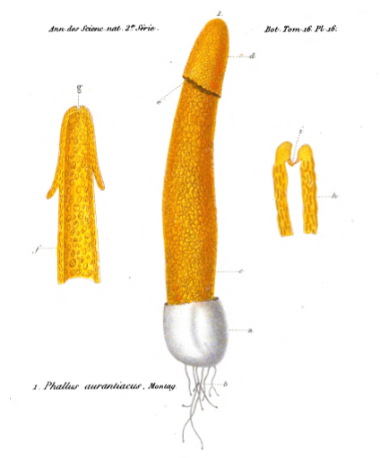Immature Fruiting Body: Like a whitish to pale brown "egg" 1.5–2.5 cm high; when sliced revealing the stinkhorn-to-be encased in a gelatinous substance.
Mature Fruiting Body: Cylindric, with a clearly differentiated head structure that is separate from the stem but may collapse against the stem surface with age.
Phallus aurantiacus Montagne, Annales des Sciences Naturelles, Botanique 16: 277 (1841); English translation of protologue by Stephen Canfield:
98. Phallus aurantiacus Montag. mss.: Cap half-free, digitaliform, reticulate, the margin serrated, the apex becoming perforated; stipe cellulose-perforated, orange.
HAB. On bare soil at the Pondicherry Botanical Garden in the shade of Spathodea and Cordia, May 1835; collected and sketched live by Perrottet.
DESC. Volva globose-oblong; one finger high; one half finger wide; outer surface alutaceous, with exserted rhizoids below that are generally simple or occasionally truncated after branching, terminal rhizoids ending in small bulbs; outer surface dark, covered with a pale, gelatinous, spermatic-smelling mass that stretches up the stem toward the cap; circumscissle. At the base there is a rudimentary cupuliform second volva, connate with the base of the first, with a limb that follows the stem for two lines. Stipe cylindric, four to five thumbs high, base half a thumb wide, apex 3-4 lines wide, hollow, completely covered with chambered depressions, orange. Cap, when it erupts from the volva, covered with white mucilaginous material in which the spores (not observed) are contained; digitaliform, delicately reticulate-rugose; concolorous with the stem; 6–9 lin. high; 9 lin. in diameter at the base and at the midpoint; at the base barely contiguous with the stipe, but not adnate, apex depressed and membranous while separated from the hollow stipe, later becoming perforated, unless development in maturity proceeds in such a way that the membrane is not ruptured. Sometimes the apex of the cap is covered with torn patch of volva.
OBS. This Phallus, similar to P. impudicus and P. iosmus, differs in color in the stipe as well as in the cap, as well as in the mucilaginous coating that covers the latter. However, this difference is not the only one; the resulting odor coming from this substance is not without significance. It is present only in maturity, and one has a very short time to observe such an ephemeral feature, which results from the rupturing of the membrane that covers the depression at the top of the cap and the cavity of the stipe. M. Perrottet has found one specimen with two individuals connected at the volva.

(Protologue illustration, public domain, adapted from a scan provided online by the Biodiversity Heritage Library https://www.biodiversitylibrary.org/page/36215825#page/421)
Pl. 16, fig. 1. Phallus aurantiacus, life size. One sees in a the ruptured volva with its rhizoids b; in c the stipe, and in d the cap, shaped like a thimble with its free margin e. Figure f shows a longitudinal cross-section through the stipe and the cap, including a portion of the latter in order to show the depression g at the apex as well as the extent to which the bottom of the cap is free from the stipe. One sees also in this figure that the interior of the stem is covered with rounded alveoli connecting with the chambered depressions that perforate its walls. Finally figure h shows the slightly enlarged cap at a point closer to maturity, when the dividing tissue that prevents the passage of outside air into the stipe cavity is reduced to a simple membrane.
This site contains no information about the edibility or toxicity of mushrooms.

